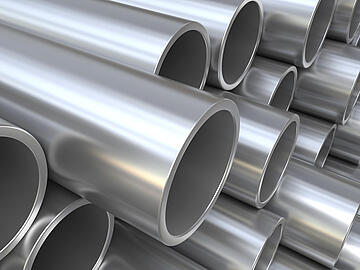
Analysis of High-alloyed Steel by HR ICP-OES Application Note · PlasmaQuant 9100 Elite
Challenge
- Trace element detection of additives and impurities in highalloyed steel products featuring complicated emission spectra.
Solution
- HR ICP-OES with high-resolution optical system in combination with a powerful software routine (CSI), being able to resolve severe spectral interferences originating from iron and refractive additives in typical steel matrices.
Introduction
Due to its excellent properties in terms of tensile strength and its high availability at comparatively low cost, steel is a major construction component in many areas such as buildings, machinery, tools, and many more. The main components of steel are iron and carbon, whereas their content defines the properties of the resulting steel grade. One way of further altering steel’s material properties such as hardness, corrosion resistance, ductility, and processability is the use of additives (cobalt, nickel, vanadium, molybdenum, and others). For instance, in the production of stainless steel, chromium and nickel are added, whereas tool steels are alloyed with large amounts of tungsten and cobalt. In high-alloyed steel, trace and ultra-trace amounts of additives and impurities have great influence on performance and grade. On the other hand, traces of elements such as phosphorus, sulfur or silicon deteriorate the properties of steel and ought to be minimized in final steel products. Reliable trace detection has thus become the key objective of many laboratories entrusted with product control and quality assurance of steel products.
For conventional ICP optical emission spectrometry (ICP-OES), the trace and ultratrace analysis of high-alloyed steel samples poses a complex problem, as more than 3,300 registered iron emission lines give rise to severe spectral interferences. Moreover, significant amounts of refractory additives, such as molybdenum or vanadium, that also contribute numerous emission lines often further complicate the emission spectra. That is, for high-alloyed steel samples, spectral interferences are infamous for impairing the quantification of trace elements such as phosphorus, aluminum, and boron.
Here, the exceptionally high spectral resolution and sensitivity of the PlasmaQuant 9100 Elite offers new analytical potential. It allows for an interference-free analysis of trace elements in a complicated matrix such as steel. Furthermore, the high plasma robustness of the high-frequency generator and the sample introduction system with its centerpiece, the V-Shuttle torch, allow for the analysis of high matrix samples with high accuracy and high precision. For severely complicated spectra, powerful software tools such as the fully automatic baseline fitting ABC and the CSI-tool for mathematical correction of spectral interferences significantly ease data handling and ensure highest data quality.
Download the complete Application Note
Contact us
The newsletter of Analytik Jena frequently keeps you posted about:
- News
- Trends and developments
- Events
